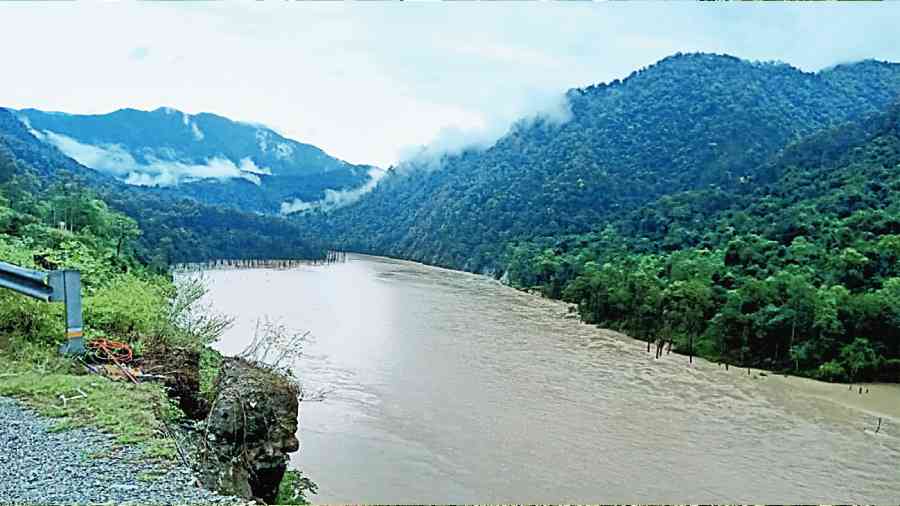A policy maker in Bangladesh has said the nation doesn’t stand a chance of getting extra Teesta water from Bengal from a realistic point of view and his country should, instead, construct a reservoir or storage infrastructure on the river with financial support from India to conserve monsoon water.
Manjur Ahmed Chowdhury, the chairman of the National River Conservation Commission in Bangladesh, told The Telegraph that the proposal was personal. “But I have shared it with many in the government,” added Chowdhury, whose views are important in the neighbouring country’s water diplomacy.
Chowdhury was speaking on the sidelines of an international water conference held at Sylhet in Bangladesh recently. The meet was organised by Action Aid Bangladesh.
Asked whether the Bangladesh government had principally agreed to the proposal and had taken it up with India, the river expert pleaded ignorance. He didn’t comment either when asked for an estimate for the reservoir on the Teesta that flows into Bangladesh from north Bengal.
The Bangladesh government has been keen for several years on a treaty to ensure the flow of water into the country even in the lean season. A deal, acceptable to both India and Bangladesh, was about to be signed in 2011, but it could not be sealed because of opposition from Bengal chief minister Mamata Banerjee.
Although New Delhi and Dhaka held several rounds of discussions to resolve the issue in the last decade or so, there has not been any progress.
“Realistically speaking, Bengal will not be able to divert water to Bangladesh during the lean season, as it has diverted almost all water through Mahananda link channel at Gajoldoba to support agriculture and cater for drinking water needs... (moreover) from the political point of view, the Trinamul Congress is weak in northern districts (in Bengal) and hence, will not be ready to share any water at the cost of their political capital,” explained Chowdhury.
The opinion seems to be a step down from Bangladesh’s long-standing demand for a reasonable share of the Teesta water.
“We need to conserve monsoon water for the dry season, and that is expensive.... Either India should directly fund it or Bangladesh may build the reservoir or storage capacity around Dalia, where we already have a barrage, with its own funds and subsequently, increase the river transit tariff on India... India should bear the cost,” added the official.
The fact that Bangladesh has been trying to find alternative solutions to the Teesta impasse became clear in recent months when China mooted a multipurpose river management project on the Teesta and a section of officials in the Sheikh Hasina government began warming up to the proposal. The much-talked-about project involves dredging, building reservoirs, laying a drainage system along the river and constructing embankments and satellite cities on either bank.
Although a section of the Bangladesh bureaucracy considers it as the most viable solution to the irrigation needs of farmers in the northern region of the country, there are also views against holding the hand of China for geo-strategic reasons.
“First, India is keen that Bangladesh does not get into a project with China on the Teesta, hardly about 100km from India border.... Second, there are also fears of Bangladesh falling into a debt trap post the developments in Sri Lanka and Pakistan,” explained a Bangladeshi water expert working closely with the government.
As discussions continue in Bangladesh on the optimal solution, some think that it’s worth exploring the possibility of involving both India and China in the exercise.
“If India and China can work together on matters related to climate change, why not on the river?” asked Professor Imtiaz Ahmed of Dhaka University, who works on the geopolitics of water in south Asia and was present at the Sylhet conference.
River expert Ainun Nishat, however, has a different view. “Such a step will not provide a long-term solution. Rather, I think river experts from both the countries should sit together with an open mind; and try to find a solution which will benefit most people on the banks of the Teesta.... Let politics follow the scientific solution,” he observed.
Nilanjan Ghosh, an ecological economist and the head of the Observer Research Foundation, Calcutta, said a sustainable solution would not be possible unless Bangladesh started thinking about a crop diversification programme so that less water was used for irrigation purposes.











